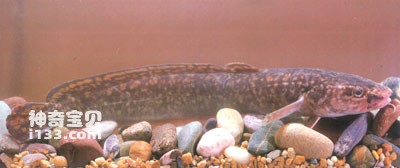Burbot (Lota lota) belongs to the order Codidae, the family Codidae, and the genus Burbot. Commonly known as: mountain cod, mountain catfish, catfish. English name: Burbot.
The body is long, cylindrical in front and flat on the back, resembling a catfish. The head is large and slightly flat; the snout is slightly rounded and blunt. Oral position. The lower jaw is protruding and slightly longer than the upper jaw; both the upper and lower jaws and vomer have villous teeth. Small eyes. There is a pair of small whiskers in front of the nose; one whisker, which is twice as long as the eye diameter. The gill openings are large, and the gill cover membrane is separated and not connected to the isthmus. The body scales are small, oval, and buried under the skin rich in mucus glands; the head is scaleless. The anterior part of the lateral line is high, the posterior part is mid-level, and it is often incomplete. There are 2 dorsal fins, the first dorsal fin is short, the second dorsal fin and anal fin are long and opposite. The pectoral fins and pelvic fins are small, the pelvic fins are located at the throat, and the 1st and 2nd fin rays are slightly extended and filamentous; the caudal fin is oval. The body color varies greatly, usually dark brown or grayish brown on the back, and gray-green in autumn; the ventral side is lighter; there are often many irregular black and yellow spots on the sides and fins, and the edges of the fins are black.

Burbot is distributed north of 40 degrees north latitude. It is a famous freshwater cold-water bottom-dwelling and ferocious fish. It likes to live on the sandy bottom with clear water or in river bends where aquatic plants grow. It is accustomed to swimming in dense grass. Camp alone. Juvenile fish mostly live on the shore, while adult fish mostly live in deep water. In summer, due to the increase in water temperature, they swim to places with lower water temperatures in mountain streams, where their activity decreases and they are mostly in a dormant state. At this time, their nutrition is poor and their body color becomes gray-brown. In autumn, they become active again and migrate from mountain streams to rivers. Overwinter in depth. The adult fish remains diurnal and emerges at night, hiding in caves or under steep rocks during the day and not moving much; it is more active at night and looks for food everywhere. Burbot feed on fish such as small whitefish, crucian carp, catfish subfamily, smelt, mandarin fish, perch pond snakehead, lamprey eels, etc. They also eat various fish eggs and juveniles, as well as juvenile fish and eggs of the same species, and sometimes Eats a small amount of aquatic insect larvae, benthic animals and frogs. The food intake in winter is larger than that in summer, and there is almost no food intake in summer. Fish at 3-4 years old reach sexual maturity, and the spawning period is from November to March of the following year. During the spawning season, when the water temperature is close to 0°C, adult fish often swim in groups to the spawning ground and lay eggs on the sandy bottom with a water depth of 2 meters. The number of eggs conceived is 5-3 million; the eggs are yellow, about 1 mm in diameter, non-sticky, transparent and rich in fat. The eggs float or are attached to other objects.
Mostly distributed in Eurasian rivers and lakes north of 45 degrees north latitude, and east to the Heilongjiang River Basin. It is produced in Heilongjiang, Songhua River, Wusuli River, Yalu River and Irtysh River in my country.
It grows slowly and can reach a maximum length of 1 meter and about 25 kilograms. Common individuals are mostly about 300 millimeters in length and weigh about 2 kilograms. The liver of burbot is large, accounting for 6-9% of its body weight. It is extremely delicious and edible. It is also the only freshwater fish in the cod family that produces cod liver oil, so it is an important economic fish. But the meat is not tasty and not popular. Its muscle contains 14.6% protein and 0.6% lipid. The meat can be used as medicine to treat bruises, bruises, hemoptysis, and constipation. Bone roasted powder has a significant effect in treating athlete's foot. Liver oil has a certain effect on bedsores, burns, traumatic wounds and ulcers, inflammation of the vaginal opening, cervix, etc. It can accelerate the formation of epithelium and make it heal without scars.
animal tags:
We created this article in conjunction with AI technology, then made sure it was fact-checked and edited by a Animals Top editor.